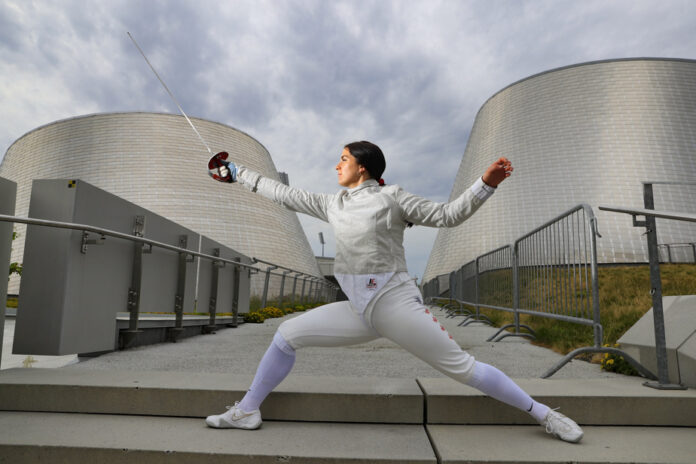All of the athletes interviewed for this story described their anterior cruciate ligament (ACL) rupture with a “pop” sound. Like when a rubber band breaks. Or that a career takes an unexpected turn.
Fencer Gabriella Page was in her fifth week of convalescence when she showed up, on crutches, at the Café Dépôt on Boulevard Curé-Labelle, in Blainville.
On May 10, she suffered her second ACL tear in less than a year. She was operated on July 26.
A year earlier, in July 2022, at the World Championships in Cairo, Egypt, his ligament ruptured for the first time. It also required an operation on August 24, 2022.
“These two injuries happened when I knew my best performances,” said the Olympian.
In his sport, the athlete stands in a position in which the back knee is always at an angle. It is with this supporting leg that fencers land on defense and explode on offense. Thus, the ligaments of the knee are constantly stressed.
Her first tear came in the round of 64 at Worlds, when she landed on her back leg. The Blainvilloise immediately collapsed to the ground. “The pain…It hurt so much every time I lunged or changed direction. A day later, it was swollen and it hurt too much. »
The second time, a few months ago, Page was training, just before an Olympic qualifying event in Georgia. Again, in a defensive step, his back knee buckled, bending the wrong way as he landed.
“There, it was a shock. There, I knew it. And I was crying saying ‘not yet, not yet,'” the 28-year-old recalled.
The tear, she said, “fucking hurts!” “.
“At the time, I didn’t scream. I just fell and wondered what was happening. And why did it still happen to me. »
However, she resisted for some time before proceeding with the surgery.
“I was aiming for Worlds and in week six I practiced and felt my knee was so unstable against some kids I’m teaching. I thought about it for a month, but in the end, I had to have surgery. »
Audrey McManiman, a specialist snowboard cross rider, has a similar story. The difference is that 11 years have passed between his operations.
In 2011, the athlete from Saint-Ambroise-de-Kildare took part in a ramp competition, in a parking lot covered with residual snow from an arena. “A scenario not too winning, but me at 16, I wanted to be the only girl who was going to compete. »
After landing, his sensations in the knee were “weird”.
“But I did it another time, and it didn’t work. My knee was swollen like a potato. I walked home, but my ligament was broken. »
A few months later, in a slopestyle competition in Ontario, his fate took a turn for the worse. “I went too far down a cannon ramp and landed five feet too far, in front of the judges, and I knew it. »
She had to have surgery on both knees. One month apart. On August 16, she had to undergo a third operation because her ligament had failed again. This time, mainly due to wear and tear.
“I don’t know when in the last 11 years my ACL failed, I think it was gradual. For 10 years I had pain and swelling, but I thought that was normal since I had surgery when I was young. »
Without it being sudden, his knee atrophied. Although she was able to put off the inevitable for a while, the pain caught up with her, necessitating an operation. She still took part in many competitions with a massacred knee.
“With the ice, the exercises and the physiotherapy, I was running away from it. It may have camouflaged a lot of micro tears, ”explains the Olympian during a Zoom meeting, from her apartment in Quebec, when she was in her third month of recovery since her most recent operation.
Even though he was injured one fall evening in 2015, offensive lineman Luc Brodeur-Jourdain remembers the streak that led to his tear in great detail.
“We had broken the line of engagement, Tyrell Sutton had overflowed on the outside and I was in pursuit mode to go and block someone further down the field. Tyrell made an inside cut and he got tackled by a defensive player and both fell on my knee, outside to right, the same time I planted my foot in the ground explains the Montreal Alouettes’ offensive line coach after practice.
He also recalls the seconds that followed: “You feel a break, you feel a pop and you know it’s not normal. I felt it was different. That there was a lousse inside. His leg had gone limp like “spaghetti,” he says.
Instinctively, people who are victims of such a tear utter a violent cry. It’s a reflex. This was the case for Brodeur-Jourdain: “I’m pretty sure I let go of a good wack! If I had had a microphone on me, surely there would have been a few beeps. »
Sarah Bérubé is a physiotherapist for the Montreal Alouettes. It often has to do with ailments related to the anterior cruciate ligament, precisely because it is a widespread injury, but also because the knee is a nerve joint in the human body, especially for football players.
“It’s like a very strong rubber band that holds two bones together to limit movement. So if this movement is forced by outside contact, that is what will break the ligament, to varying degrees. It’s not always necessarily torn completely, but it’s still a big injury, ”explains Bérubé in detail.















